Mastering LinkedIn Personal Branding for B2B Success
7th June 2023 •
7th June 2023 •
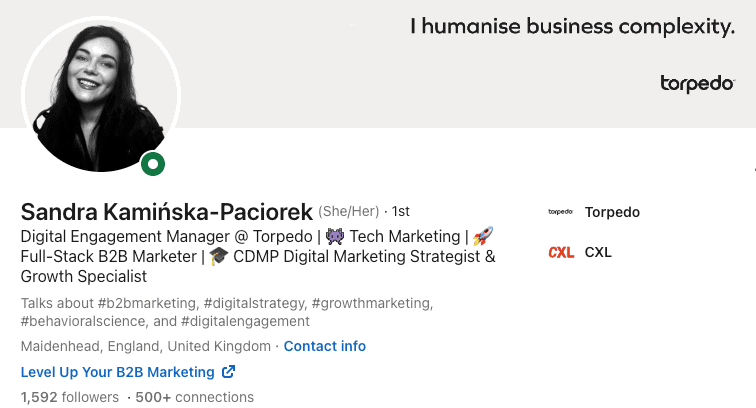
Personal branding used to promote mainly public figures and celebrities, but in recent years it has taken the world of modern business by storm. A strong personal brand helps modern B2B leaders stand out in competitive fields.
People buy from people – and this is particularly true for B2B organisations, where the average deal size is significantly higher than its B2C counterparts. Your personal brand can help establish trust and build relationships, which could be a deciding factor when it comes to converting a sale. In simple terms, an established personal brand can help you drive revenue.
When it comes to branding yourself, there are many online mediums you can use to build your presence. But, none can match the advantages of LinkedIn – a social media platform that enables you to reach 900M professionals in 200 different countries and regions worldwide.
In this blog, our Personal Branding expert will walk you through the foundations of establishing a strong personal brand on LinkedIn and how you can best leverage it to drive B2B marketing success.
A personal brand is a unique value proposition that you bring to your organisation and the wider industry. A personal brand is intentional, and it’s all about how you want to be perceived. It involves establishing your expertise, values, and personality in a way that reflects positively on your company and helps you stand out in your industry.
A great example of a strong personal brand in the marketing world is Gary Vee.
Gary’s personal brand is a great example of a “founder’s brand”, where brand awareness and positioning of an organisation are generated through a personal profile of its founder/top executives. This practice is especially popular in tech start-ups and niche companies.
So, if you are a business leader focused on spreading the word about exceptional leadership skills or a B2B Marketing Director who could talk about successful GTM strategies for hours, LinkedIn gives you a platform to bring your personal brand to life and expand it globally.
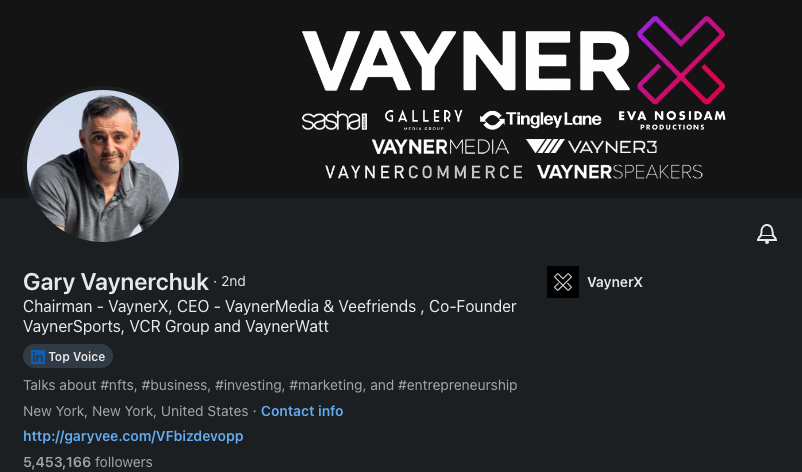
Now that we know what a personal brand is, where does it belong in a B2B lead generation strategy?
Building credibility and trust in B2B is crucial, especially as the sales cycle is notably longer. According to Databox, the median value of a B2B sales cycle length is 2.1 months. In some instances, it can take up to six months for a company to decide on whether to buy (or not) from you.
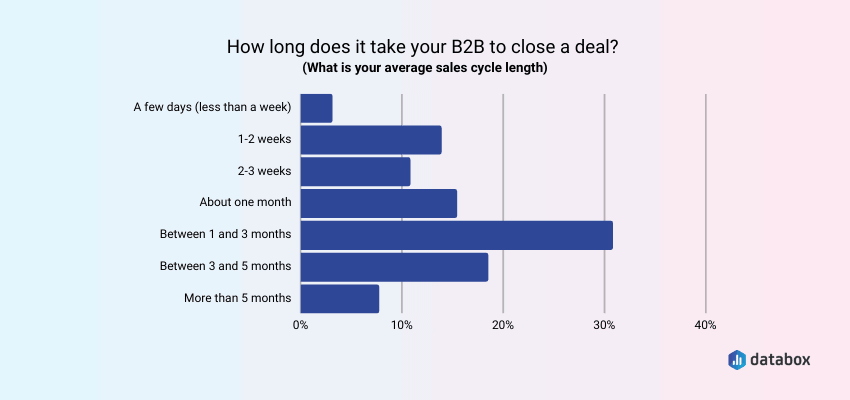
First off, your solution will be evaluated by multiple stakeholders. From process influencers through procurement, financial teams, and budget holders, there is a good chance every person involved in the buying process will carry out their independent research. And LinkedIn is one of the places they will go to for help.
The diagram below accurately illustrates a modern B2B buying process:
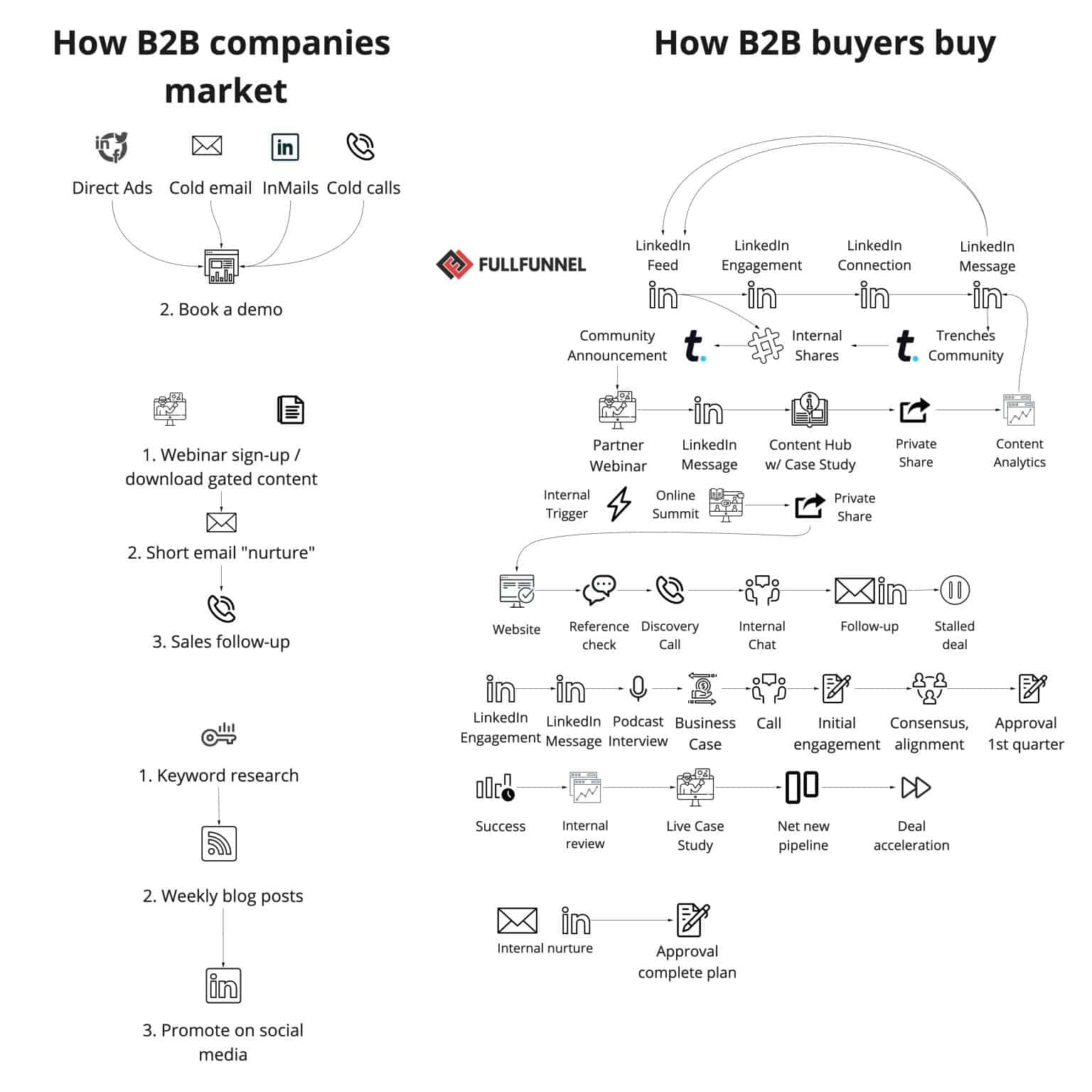
LinkedIn’s definition of the 95-5 rule is that 95% of your potential buyers aren’t ready to buy today. This 95% are “out-of-market” today but will be “in-market” sometime in the future – so it’s important that you create a demand for your product before they are ready to buy.
Once potential buyers are in the market for a solution like yours, Gartner’s research discovered that B2B buyers loop around different stages multiple times before making their decision. The same research also showed that salespeople have only 5% of customers’ time during their buying journey – so it’s important that you become that go-to person when your prospect is ready.
LinkedIn allows you to effectively connect and engage with B2B decision makers before they are even aware of their challenge, let alone your product. An established personal brand will help you become a go-to expert once your buyers recognise their challenges. They may even bring you qualified leads outside your audience as referrals.
Having an established personal brand can also increase your perceived value. As you grow your personal brand and you become an expert within your niche, people will start thinking about you on a more emotional level and will connect with you more deeply, increasing your value to them.
When it comes to choosing the right platform to build your personal brand on, LinkedIn is an obvious choice. The platform describes itself as a place “where professional relationships are forged, careers are developed, and business is done.” According to research from Kurve, 80.33% of B2B leads are generated through LinkedIn.
What makes LinkedIn truly unique when compared to other social media platforms is its authenticity and business focus. In contrast to fun-focused social channels, LinkedIn’s feed is filled with substantive, in-depth content, which is often curated by thought leaders with strong personal brands.
Now, you might argue – why do I need a personal brand if I have a company page?
The answer is easy: LinkedIn, like any other platform, has a complex algorithm and in LinkedIn’s case, it favours personal content.
If you log in to your LinkedIn account, chances are that 80% of your feed will be filled with posts from people you follow or are connected to. The remaining 20% will be split between paid ads and content from companies you follow – which explains the lower engagement rates that can be observed on business pages.
To succeed in the LinkedIn environment, you need a personal profile that combines the best of both worlds – business content and personal touch. This can be achieved with a personal brand.
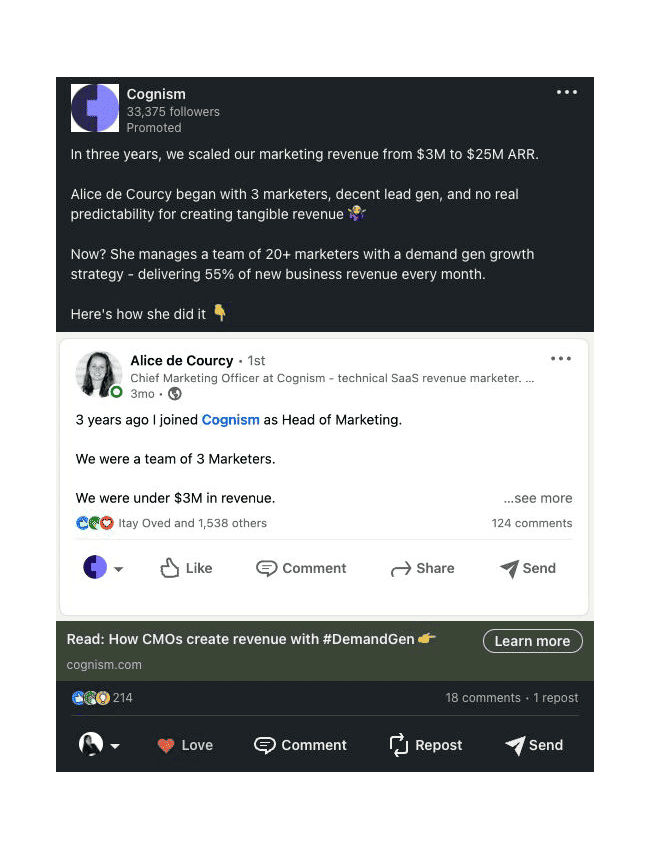
Think of LinkedIn as a massive networking event – where people meet and exchange ideas, which can eventually turn into fully-fledged business opportunities. However, to make those deals happen, you need to have an established personal brand.
A great example of a B2B tech brand that understands the importance of personal brands and their role in B2B marketing is B2B messaging testing platform, Wynter. As a part of its social media strategy Wynter not only distributes informative content through its own profile, but also works with its employees to promote the content through their networks. Although Wynter’s LinkedIn profile consists of an excellent content mix, the truth is they wouldn’t reach as many people if it wasn’t for Laja who amplifies it through his personal account.
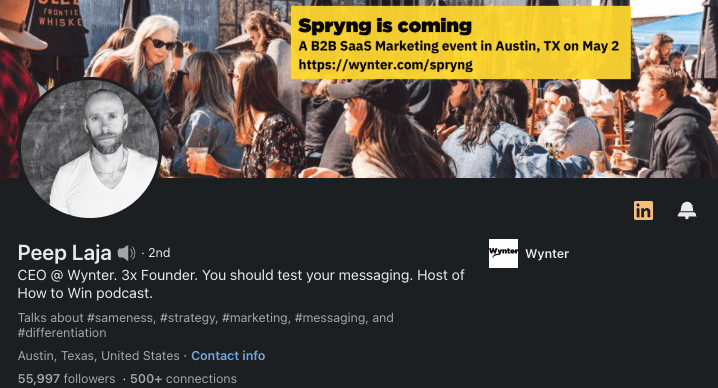
The biggest difference between business and personal profiles is that individual accounts see a massive spike in engagement and interactions when it comes to promoting business content.
In the example below, it’s clear that although Wynter and Peep shared the same image and similar message, the overall engagement varies significantly between business and personal profiles. This is something worth considering when it comes to planning a B2B content distribution strategy.
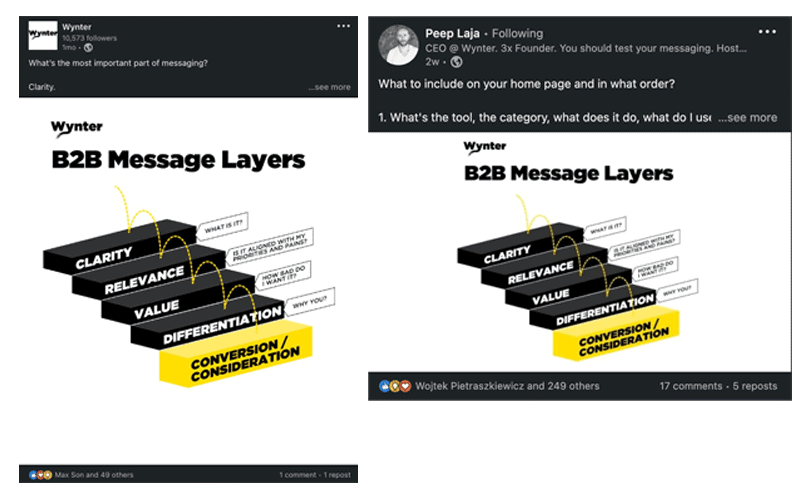
Optimising your LinkedIn profile for personal brand…
Starting a personal brand on LinkedIn can be challenging, especially if you are low on spare time or you don’t have enough knowledge about LinkedIn and how it works. However, before we move to strategy, let’s make sure that you have the foundations right.
To get your profile visible on LinkedIn, it must be properly optimised. Here’s what you should be paying attention to:
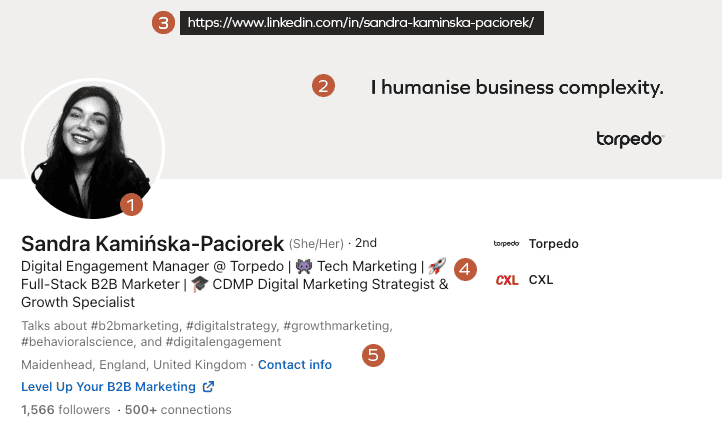
It’s not only about optimising your personal LinkedIn profile though. You also need to consider your content strategy.
Imagine you are selling a MarTech tool – how do you make people want to trial it, especially if awareness levels of your product are low? You certainly don’t want to force it down your prospect’s throat by sending a link to it via a direct message as soon as they accept your connection invite. Instead, you should be consistently sharing content that explores the benefits of your tool and how it helps to solve the challenges your audience might be facing.
If you want to be successful on LinkedIn, you need to be consistent. Unfortunately, this isn’t always the case, especially for busy executives. So how do you come up with a LinkedIn content strategy that generates conversions?
LinkedIn is a fast-growing platform with new features added regularly. And, as with any other social media platform, it might be challenging to keep up.
If you are thinking about generating a LinkedIn content strategy, our upcoming blog LinkedIn Content Creation for Personal Branding Success will provide you with expert knowledge on the content frameworks available in LinkedIn.
To help you leverage all the core capabilities of LinkedIn, you can seek professional help from a B2B marketing agency like Torpedo which can conduct an audit of your LinkedIn activity to date, other influencers in your niche, and what you can do to outperform them. If you are planning to roll out an idea of personal branding to your entire team, we can help too.
Conducting a LinkedIn audit will present you with multiple opportunities including content gaps, topics other influencers cover, and how you can align your LinkedIn strategy moving forward so it supports your brand’s values. Based on the audit findings, you will then be able to define an effective LinkedIn content strategy.

Our team can help you not only establish your personal brand but also incorporate it with a highly effective B2B lead generation strategy.
Get in touch